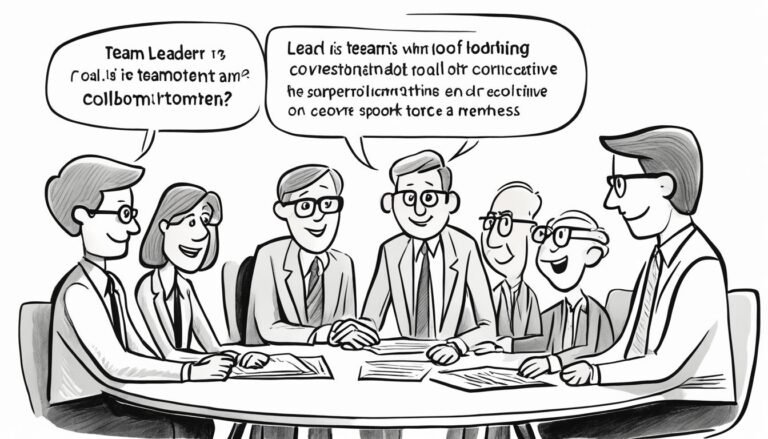Leadership in Project Management: Delivering Results
“The greatest leader is not necessarily the one who does the greatest things. He is the one that gets the people to do the greatest things.” – Ronald Reagan
Leadership in project management is crucial for success. It’s not about doing big tasks yourself. It’s about inspiring your team to achieve amazing results. No matter the size of your project, leading with expertise matters.
You must inspire and guide your team. This way, they can achieve their best work on schedule and within the budget.
Key Takeaways:
- Effective project management requires strong leadership skills
- Motivating and empowering your project team leads to better outcomes
- Delivering results on time and on budget is the ultimate goal of project management
- Successful project leaders inspire and enable their teams to achieve greatness
- Leadership in project management is about getting the best out of people
The Importance of Defining Scope and Objectives
When starting a project, the first big step is to define its project scope and objectives. This sets a clear path for success. It makes sure everyone knows what’s expected, their jobs, and what the project aims to achieve. This step helps avoid problems like scope creep and misunderstandings, thus saving time and money.
It’s key to let the team and others involved know the project expectations and success criteria. This guides the team’s efforts and gives them a clear target. Everyone will understand their part and how it helps reach the project’s goals. It also informs stakeholders about the project’s purpose and what they can gain.
“The clearer the scope and objectives, the easier it is to align the team and track progress.”
Setting the project’s goals also boosts team alignment. It makes sure everyone is working in harmony towards achieving the same targets. When roles and goals are clear, team members are more likely to be committed and focused.
This approach also makes it easier to track progress. Clearly laid-out milestones and goals allow for easy monitoring. This way, you can keep the project on track and deal with problems early on.
Defining goals also increases team engagement. When the team helps set the project’s direction, they feel more dedicated to its success. This leads to a happier and more productive team.
Finally, a project’s success hugely depends on how well its scope and objectives are set. With clear focuses, projects can be managed and evaluated effectively. They promote good communication, unity among the team, and the monitoring of progress and team participation. All these elements are vital for a project’s triumph.
Planning and Scheduling for Success
After setting the project’s goals, planning and scheduling tasks come next. A clear plan helps keep the project on time and its goals achieved.
It’s key to divide the project into parts. This makes it simpler to manage and track progress. Project management tools are great for this, helping to coordinate everything efficiently.
The Gantt chart is a favorite for planning. It shows tasks and their timeframes clearly. This way, project managers can focus on what’s most important and allocate resources the best way.
Also, planning means deciding who will do what. Projects run smoothly when the right people work on tasks that matter most at the right time. This helps achieve the project’s main points and meet set deadlines.
But, things can change in a project. Project managers need to be ready to tweak plans when necessary. They must adjust deadlines, move resources around, and keep everyone in the loop about these changes.
Key components of project planning and scheduling:
- Breaking down the project into manageable phases
- Utilizing a project management tool like a Gantt chart
- Allocating resources based on skills and availability
- Prioritizing tasks to ensure timely completion
- Adapting and managing changes effectively
By planning, using tools like Gantt charts, and managing resources and changes efficiently, project managers can lead their projects to success.
Effective Communication and Collaboration
Good communication and teamwork are key for project success. They help keep everyone on the same page. It’s all about making sure everyone knows what’s going on when they should.
It’s not just about talking, though. It’s also about listening and working together. When we listen well, we understand each other’s needs. This helps us work better together and do a better job.
Encouraging team spirit and sharing ideas helps, too. This way, everyone can give their opinion. It makes people feel valued and often leads to great new ways of doing things.
Communication and working together can also solve problems when things go wrong. By talking openly, we can fix issues before they get big. This keeps the project running smoothly.
Benefits of Effective Communication and Collaboration:
- Improved project coordination and efficiency
- Enhanced stakeholder engagement and satisfaction
- Greater team cohesion and collaboration
- More effective problem-solving and decision-making
- Reduced conflicts and improved conflict resolution
“Good communication does not mean that you have to speak in perfectly formed sentences and paragraphs. It’s about connecting with your audience and conveying your message clearly.” – Anonymous
Let’s see why communication and teamwork are vital with a quick example:
| Communication Challenge | Consequences | Resolution |
|---|---|---|
| A project team member receives incomplete information about a task. | Misunderstandings and delays in task completion. | The project leader sets up clear ways to communicate. This way, everyone gets all the info they need. No more half-incomplete jobs. |
| Stakeholders are not actively engaged in the project. | Lack of stakeholder support and potential project scope changes. | The project leader starts regular updates with stakeholders. This makes them feel part of the project. Now they support and understand it more. |
| Team members have differing ideas on how to approach a project challenge. | Confusion, conflicts, and delays in decision-making. | The project leader gets everyone to talk and share their ideas. Then, they all pick the best plan. This makes decisions faster and moves the project forward. |
Motivating and Empowering the Project Team
Leading a project team well is all about motivation and empowerment. This drives them to be more involved, committed, and confident. To empower your team effectively, leaders need to recognize their efforts.
This can be done by praising them, offering incentives, or simply acknowledging their work publicly. Feeling valued and appreciated boosts team members’ motivation. Subsequently, they perform better.
Giving feedback is as crucial as recognition. Feedback should be helpful, encouraging, and aimed at progress. It should highlight both strengths and areas for improvement. This creates a culture of ongoing growth and learning.
Delegation is key for empowering team members. By assigning tasks that match their skills, you give them ownership. This not only helps with the workload but also promotes individual growth.
Letting team members make decisions also boosts empowerment. Their involvement in the decision-making process shows you trust their judgment. This fosters their sense of responsibility and autonomy.
Supporting team growth through coaching and training is beneficial. It improves the project’s success by enhancing their performance. Encouraging skills development creates a dynamic team that’s always improving.
“Empowering the team helps unlock their full potential and achieve exceptional results. When team members feel motivated, recognized, and empowered, they become more engaged, committed, and confident in their abilities.”
Motivating and Empowering Strategies:
- Implement recognition programs to acknowledge team efforts and achievements
- Provide regular and constructive feedback to guide individual and team growth
- Delegate tasks based on individual strengths and capabilities
- Empower team members with decision-making authority
- Offer training, coaching, and mentoring opportunities for professional development
Benefits of Team Motivation and Empowerment:
- Increased engagement and commitment
- Improved performance and productivity
- Enhanced problem-solving and decision-making
- Higher job satisfaction and morale
- Greater innovation and creativity
| Team Motivation and Empowerment | Key Factors |
|---|---|
| Recognition | Appreciating team efforts and achievements |
| Constructive Feedback | Guiding individual and team growth |
| Delegation | Assigning tasks based on individual strengths |
| Decision-making Authority | Empowering team members to make decisions |
| Training and Coaching | Supporting team learning and development |
Monitoring and Controlling the Project
Good project management makes sure things stay on track. Leaders keep an eye on how the project is going and make sure it’s meeting its goals. They use a system to watch progress, find places to do better, and keep the project on time and target.
Checking on progress regularly is a big part of leading a project well. It helps to see what the team has done and if it matches the plan. It’s a chance to fix things early and keep the project moving right.
Looking at how well the team is doing is also very important. Leaders figure out what their team is good at and what they need to work on. They help the team do their best job. They also find ways to cheer the team on, which makes everyone work even harder.
Knowing and handling risks is key in project management. Leaders must always look out for things that might go wrong. They figure out what risks are out there, see how bad they could be, and stop them before they mess things up. This makes sure the project doesn’t get off track.
Solving problems that come up is a big part of a leader’s job. Sometimes, stuff just doesn’t go as planned. Leaders jump in to fix these bumps fast. They figure out the main problem, come up with a fix, and make sure it doesn’t happen again.
Project insights are also crucial. By keeping an eye on certain measures, leaders can see what’s working and what’s not. They can make changes based on this data to keep the project moving forward. For example, they might look at the budget, the schedule, or how happy the customers are.
Overall, managing and staying in control of a project is vital. It means watching, improving, and solving issues as they come up. With good eyes on the project, leaders can steer it towards success.
| Key Elements of Project Monitoring and Control | Description |
|---|---|
| Progress Reviews | Regular assessments of project progress against planned scope, objectives, and schedule. |
| Performance Evaluation | Evaluating the team’s performance and providing necessary support to enhance productivity. |
| Risk Management | Identifying, assessing, and mitigating potential risks that may impact the project. |
| Issue Resolution | Promptly addressing issues and challenges to minimize their impact on the project. |
| Project Metrics | Defining and tracking relevant project metrics to gain insights and make data-driven decisions. |
Celebrating Success and Learning from Experience
Project leaders know the value of celebrating success. They boost team spirit by recognizing everyone’s hard work. This makes the work environment positive and pushes teams to keep getting better.
Celebrating wins boosts team morale and unity. It doesn’t matter if it’s a small win or a big project success. Acknowledging these moments brings everyone together and makes them proud of their work. This can be through parties, awards, or simple thank-yous. Project leaders use these celebrations to create a team that supports and motivates each other.
Importance of Project Reviews
Project reviews, or post-mortems, are key in learning and growing. Teams look back on their work, talking about what went well and what didn’t. This helps them figure out what they can do better next time.
These reviews also help teams see how good they are in planning, talking, and solving problems. By spotting weak spots, leaders can push for change and do even better next time. Celebrating when things go right strengthens a culture of achievement and new ideas.
“We don’t just celebrate our successes; we learn from them. Project reviews are an integral part of our continuous improvement process, allowing us to identify areas of strength and opportunities for growth.” – Jane Smith, Project Manager
The Power of Continuous Improvement
Getting better never stops. Leaders push their teams to look at every project as a chance to learn and grow. This keeps the team thinking creatively and always ready to face new challenges.
Leaders create a space where everyone feels they can suggest and try new ideas. They do this by talking often, brainstorming, and keeping communication open. This focus on new ways and getting better makes their project teams ready for anything.
Celebrating success and learning are key to leading well. By cheering wins and reviewing, they push their teams to keep improving. This helps make sure projects go well, bringing great results and setting up for future victories.
The Role of Project Leadership
Project leadership is key in finishing a project with success. It includes many tasks like managing the team and project culture. Below, we look at what project leadership involves:
- Project Leadership Definition: It means guiding a project from start to end. This includes making sure it meets its goals and the needs of those involved.
- Project Leader Responsibilities: Project leaders set a vision for the work and its goals. They handle the team, giving tasks and keeping an eye on progress for success.
- Team Management: Leading a team well is crucial. Leaders work on teamwork, keep them motivated, and make sure resources are used well for better work.
- Project Culture: A positive project atmosphere is a must for success. Leaders create such an environment by encouraging new ideas and working together.
- Stakeholder Engagement: Keeping stakeholders involved throughout is important. Leaders set up good ways to talk, include stakeholders, and solve their issues for a winning project.
- Decision-Making: Leaders make decisions by looking at data and team feedback. They think about risks and other factors to make smart moves for the project.
- Project Director vs. Project Manager: Roles of a director and a manager differ but are key. Directors focus more on the big picture and strategies, while managers handle day-to-day project work.
Project leaders are essential for project wins. They face problems, use resources well, and motivate the team to do great. By using good leadership, companies can improve their project results and meet their goals.

Conclusion
Leading a project needs a wide mix of skills, know-how, and theories to make it work. Good leaders are great at talking, leading teams, solving issues, inspiring, and focusing on solutions. They adjust how they lead depending on the project, using different leadership theories.
It’s also key to be good at project management and use digital tools for project success. Keep improving your leadership skills, and know the best ways to lead, helps leaders get good results. This drives the project to succeed.
Improving your skills in leading projects, picking the right way to lead, and using project management know-how is important. It helps leaders handle the challenges of project management and get their teams to shine. With the right skills, project leaders can make their projects a success.
FAQ
What is the importance of project management leadership?
Project management leadership is key in reaching project goals. It motivates and empowers teams. It ensures everyone communicates well and works together. It also keeps an eye on the project’s progress and performance.
How can I effectively define the scope and objectives of a project?
Define the project’s scope and objectives clearly and make them realistic. This action helps set team expectations and roles. Share the project’s purpose, benefits, and success criteria with the team. This gives everyone a clear direction and focus.
What is the role of planning and scheduling in project success?
Planning and scheduling are vital for meeting project goals. You break the project into tasks and set deadlines. Use tools like Gantt charts to track progress. This helps you manage changes and keep the team’s work on target.
How important is communication and collaboration in project management?
Communication and teamwork are key to project success. Regular, clear communication with the team and stakeholders is vital. It keeps everyone informed and on the same page. A culture of working together helps share ideas and feedback openly.
What are some strategies for motivating and empowering the project team?
To motivate and empower the team, show you appreciate their work. Give them tasks that match their skills. Let them take ownership of some decisions. Also, support their growth by providing training and coaching.
How can I effectively monitor and control project progress and performance?
Keep an eye on the project’s progress regularly. Compare it against the plan and schedule. Address any risks or issues. Use metrics and tools to guide you. This helps keep the project on course for success.
Why is it important to celebrate project success and learn from experience?
Celebrating a project’s success boosts the team’s spirits. It keeps them motivated. Reviewing the project afterwards helps find ways to do better next time. It encourages learning and new ideas.
What is the role of project leadership in guiding a project to success?
Project leadership sets the project’s vision and manages resources. It creates a positive team and project culture. It engages stakeholders and makes key decisions. Leaders ensure everyone works towards the same goals.
They could be project directors or managers. Both are crucial for the project’s success.
What skills and competencies are essential for effective project leadership?
Good project leaders are great at communication, leading teams, and solving problems. They motivate their teams and work towards solutions. They adapt their leadership to the project’s needs. They always aim to improve their skills and expertise.








